|
I have always been interested in the night sky - I love to lie in the hammock and watch the metor showers.
Once you learn the night sky you can use this knowledge to estimate. time of night, direction and so much
more.
Just click on the address to open a new world.
I don't study the deep space things but I like being able to look at the stars and know the names of the constellations.
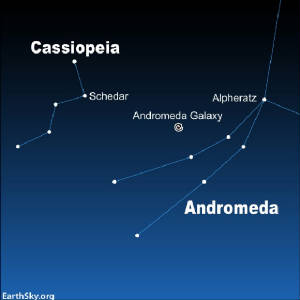
|
| Andromeda |
Andromeda Constellation — Andromeda is a constellation representing the princess Andromeda, in the northern
sky near Pegasus. The constellation takes the general shape of a long, dim, straggly letter “A”. It is most notable
for containing the Andromeda Galaxy, Cassiopeia is easy to find. It is generally northward on the sky’s dome shaped
like the letter M or W. The Big Dipper and Cassiopeia move around Polaris like the hands of a clock, always opposite each
other. The star Schedar in Cassiopeia points to Andromeda which connects to the great square of Pegasus.
Andromeda was a princess condemned to be sacrificed to a sea monster; she was rescued by the hero Perseus.
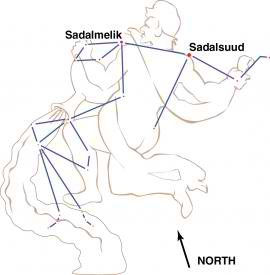
|
| Aquarius |
Aquarius, the water bearer, is very faint and hard to see and the home of the summer Delta Aquarid meteor shower. The
constellation's two brightest stars are Sadalmelik and Sadalsuud. They are ancient Arabic
names, and mean "lucky one of the king" and "luckiest of the lucky." The globular cluster M2 is located in
this constellation and the brightest stars in M2 today are yellow and orange giants.
Aquarius is situated between Capricornus and Pisces. Aquarius is the 10th largest constellation in the sky. The constellation
can be seen in the spring in the Southern Hemisphere and the fall in the Northern Hemisphere. Look for Capricornus, and from
there look for a small group of three stars shaped like a Y. This is part of Aquarius.
In Greek mythology, Aquarius is associated with Deucalion, who built a ship with his wife Pyrrha to survive
an imminent flood. They sailed for nine days before washing ashore on Miount Parnassus. Aquarius is also identified with the
youth Ganymede who was taken to Mount Olympus by Zues to act as cup-carrier to the gods.
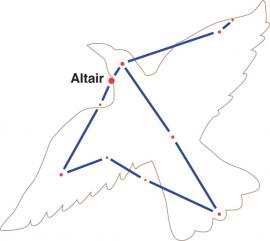
|
| Aquila |
Aquila, the Eagle travels through the Milky Way and can be seen high in the south in late summer.The brightest
star is called called Altair, the Arabic word for eagle and is the vertex of theSummer Triangle.
Aquila is the 22nd biggest star constellation in the sky.
Aquila it represents the bird who carried Zeus's/Jupiter's thunderbolts in Greece/ Roman mythology.
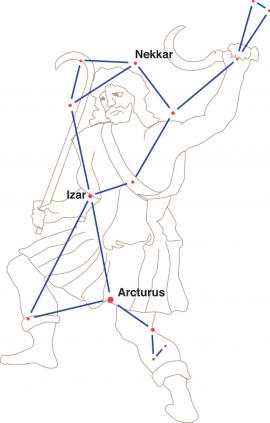
|
| Bootes |
Bootes, the Herdsman name comes from a Sumerian word that means "Man Who Drove the Great Cart." The "Great Cart"
was the Big Dipper. Bo÷tes trails the Big Dipper as it wheels around the North Star.
There are many stories that explain this costellation. Here is one of them; According to one version, Bootes
was the son ofDemeter, and a ploughman who drove the oxen in the constellation Ursa Major. The ancient Greeks saw the
" Big Dipper" or "Plough" as a cart with oxen.
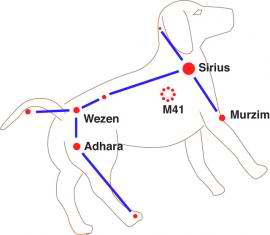
|
| Canis Major |
Canis Majot, the Great Dog loyally follows its mythical master, Orion, across the southern skies of winter.The brightest
star in Canis Major ,Sirrius is the brightest in the entire night sky.
It is said to represent one of Orion's hunting dogs, helping Orion fight Taurus the Bull.
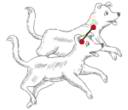
|
| Canes Venatici |
Canes Venatici lies in the northern hemisphere. Its name means “hunting dogs” in Latin.
The constellation represents the hunting dogs of Bo÷tes the Herdsman, a neighboring constellation.
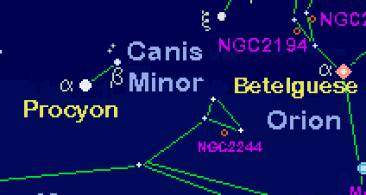
|
| Canis Minor |
Canis Minor, the little dog was thought to be a water dog since it stood on the edge of the Milky Way. Sometimes the
legends connect the dog to Orion along with the larger dog, Canis Major.
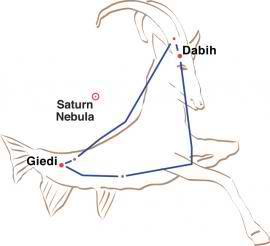
|
| Capricornus |
The Capricornus, the Sea-Goat is found low across the southern sky in late summer and fall.It is the second faintest
constellation in the zodiac after Cancer, and it is the smallest constellation in the zodiac.
Greek myth says the god Pan was transformed into a half-goat, half-fish when he dived into the Nile River to escape the
giant Typhon and now has a place in the sky.
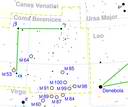
|
| Coma Berenices |
The constellation COMA BERENICES represents the beautiful hair of Queen Berenice
of Egypt. She was so concerned for the safety of her husband Ptolemy III when he went off to war, that she vowed to cut off
her glorious long hair as a sacrifice to Venus, should he be spared. When he eventually returned safely home, she kept her
promise, and Zeus placed her beautiful hair in the heavens to shine among the stars.
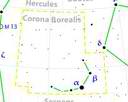
|
| Corona Borealis |
Corona Borealis, ( Northern Crown):
The Northern Crown can be found between the constellation of Hercules and Bo÷tes.It is visible in the Northern sky from
February through SeptemCorona Borealis was sometimes considered to represent a crown that was given by Dionysus to Ariadne, the daughter of Minos of Crete. When she wore the crown to her wedding, where she married Bacchus, he placed her crown in the heavens to commemorate the wedding.ber.
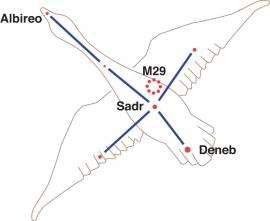
|
| Cygnus |
Cygrus, the Swan is also known as the Summer Cross and can be found high overhead during late summer evenings.
Cygnus has been identified with several different legendary swansof Greek mythology..Zues disguised himself as a
swan to seduce Leda.( Spartan king Tyndareus's wife). Leda gave birth to the Gemini, Helen
of Troy and Clytemnestra. Also Orpheus was transformed into a swan after his murder, and was said to have been placed
in the sky next to his lyre ( Lyra); and the King Cycnus was transformed into a swan.

|
| Leo |
Leo, the Lion looks like a lion in the sky. Regulus, one of the brightest stars in the night sky. Regulus rises
almost due east, with the body of the lion following it into the sky over the next couple of hours. Once Regulus climbs into
the sky, look to its left — toward the north — for a group of stars forming a backward question mark. These stars
outline Leo's head and mane. About two hours later, look low in the east for Leo's tail — a white star named Denebola
— an Arabic name that, appropriately enough, means "tail of the lion."Leo is found with Csncer to the west
and Virgo to the east.
Leo was identified as the Nemean Lion which was killed by Hercules during one of his twelve labours.
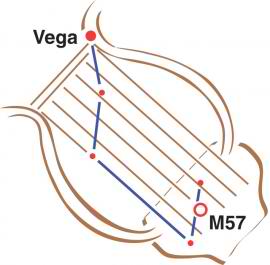
|
| Lyra |
Lyra, the Harp can be found by looking for the star Vega high overhead in mid-summer. Lyra looks like a small, lopsided
square, with Vega just beside one of the corners of the square. Lyra is visible from the northern hemisphere from spring through
autumn, and nearly overhead during the summer months.
Lyra was associated with the myth of Orpheus the musician who was killed by theBacchantes. After his
death, his lyre was thrown into the river; Zeus sent an eagle to retrieve the lyre, and ordered both of them to be placed
in the sky
The Story:
Orpheus was given a harp by the god Apollo. Orpheus' music could soothe any savage, bring joy to the heart of the weary.
Orpheus married the lovely maiden Eurydice. But after their wedding, as she walked with her bridesmaids, she was bitten by
a snake and died.
Orpheus journeyed to the underworld to win her return. His music not only gained him entry to Hades, it caused Pluto,
the god of the underworld, to soften his heart and grant Orpheus' wish. But there was one condition: Eurydice would follow
Orpheus, who could not look back until both had gained the upper world.
Despite his anxiety, Orpheus followed his instructions -- until he reached the surface. Before Eurydice could take the
final steps into the light, he turned to gaze upon her. She vanished, with only one word to her love: Farewell.
Crazed with grief, Orpheus wandered the hills of Greece until he was murdered. The Muses buried him, and Apollo placed
his magical harp in the sky -- as Lyra.

|
| Pegasus |
Pegasus, the Flying Horse
In classical Greek mythology, Perseus killed the snake-headed Medusa to save the princess Andromeda from a nasty sea
monster. A few drops of Medusa's blood fell into the sea. When it mixed with the foam, it gave birth to Pegasus
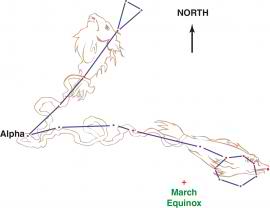
|
| Pisces |
Pisces, the Fish is best viewed during autumn and winter evenings but it is still hard to see. It lies between Aquarius
to the west and Aries to the east.
Pisces is associated with the Roman legend of Venus and Cupid, who escaped the monster typhon by transforming into
fish and tying themselves together with rope.

|
| Scorpius |
Scorpius, the Scorpion lies between Libria to the west and Sagittariius to the east. It is a large constellation
located in the southern hemisphere near the center of the Milky Way.
Three bright stars form the "head" of Scorpius while its tail curves away below it in the southern sky of summer.
Still need a litttle more help.
In the Northern Hemisphere it is easier to start with Ursa Major (The great bear) home of the Big Dipper and Ursa
Minor ( The little bear) home of the Little Dipper. Mother ( Callisto) and son (Arcas) who where placed in the sky by Zeus
to endlessly follow the north celestial pole (Polaris). Polaris is the last star at the end of the little dipper's
handle. A line drawn though the two stars that form the bowl of the big dipper runs into Polaris.
Now continue that line to the other side and you will run into top of Cephes ( The King). He consist of five bright stars
that looks somewhat like a house with a pointed roof. His wife, Cassiopeia is just to his east. Lke her husband she
is visible all year in the northern hemisphere,
Now the sky is getting interesting! Husband, wife and now the daugher, Andromeda. A line from Polaries past
the roof of Cepheus, the last star of Cassopiea leds to the the hinge star of Andromeda Andromeda is a V shaped
consellation that lays on her side. Her parents where told that they needed to sacrifice their daughter, Andromedia, to Cetus
so they chained her to a rock by the sea. Perseus aboard Pegasus came to her rescue. Pegasus and Andromedia
share that same hinged star. Another way to look at it is that Andromedia is still holding onto Pegasus. Perseus can be found
behind Andromedia and below Cassiopeia. He stand astride the Milky Way.
If you follow the Milky Way towards the south past Cassiopeia you will see a place where it divides into two
streams. Here you will find Cygnus, Zeus disguised as a gaint swan. Contiune downwrd and on the east side of the stream you
will see Sagitta, the arrow that was shot by Herculus at the Stymphalian Burds. Herculus is directly to the west Below
Cygnus is Zeus' pet bird Aquila, the eagle. At the far south in the pool of the Milky Way lays Sagittarius, The Archer.It
looks like a large tea pot.
|

